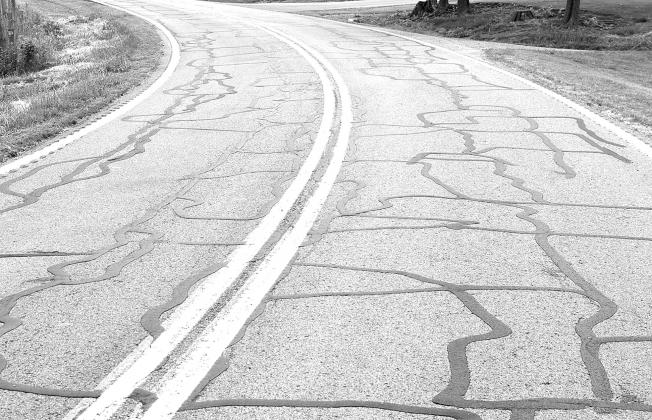While covering road cracks with tar extends the life of county roads and help fiscal court be judicious with their road funds, it can be dangerous for the many motorcyclists that enjoy Pendleton County's back roads.
There is a danger lurking on the back roads of rural counties throughout Kentucky, a danger that many motorists have taken for granted and, while they may lead to their car slipping a little, they pose no major threat.
For motorcyclists, they do pose a major threat.
As cracks begin to develop on the roads from abuse, traffic and weather, they get bigger and bigger, causing road surfaces to develop. A temporary fix is for road crews to fill the cracks with sealant, usually a soft, tar-based substance. It keeps the cracks from expanding.
With increasing cost of asphalting, it allows local decision makers to stretch out their road fund dollars and life of the roads.
A road covered in random, windy black lines resemble snakes, hence the term “tar snakes,” and Pendleton County roads are covered with them.
Motorcyclists have indicated that their bikes slip on the tar snakes, and they have to battle to keep their bike upright because they compromise their traction.
According to bikebandit.com, there are three ways it does that: 1)They have a very different texture than asphalt and motorcycle tires will respond differently to them than to the road; 2)they create a bumpy road surface that can unsettle the suspension; 3)they can become softer or slicker in hot weather, or when wet.
For a four-wheeled vehicle, it is not a major safety issue although drivers of small vehicles may feel their car slipping. In fact, my wife and I spent the good portion of June trying to figure out why her car was doing just that.
At the time, we were a little concerned and could not see any defects or issues with the tires. Being under warranty, we weighed the possibility of returning it to the dealership for inspection to figure out why it was slipping.
When my sister, Paula Thornton, called to tell me about her and her husband Donnie almost laying their motorcycle down because of a tar snake, we had our answer to Jana’s car issue.
In fact, when I was snapping the photo that accompanies this story, a resident inquired why I was snapping photos of the road. After explaining this article and the dangers of tar snakes to motorcyclists, he quickly added that in his big, burly four-wheel drive truck slips on them, too.
When motorcyclists ride over a tar snake while leaning over, they will momentarily lose traction, causing their bike to slide.
Often, they will regain traction quickly and won’t experience more than a “puckering moment” according to bikebandits.com.
They offer three pieces of advice:
1. Always scan the road surface while riding to look for them. Try to memorize where they are on roads you like to ride, because they do tend to be clustered in patches.
2. When you ride over them, reduce your speed (of course) and try to ride over them vertically, at a 90-degree angle, if possible. Avoid those that go along your line of travel.
3. Your bike may wobble or shudder as you ride over them, so remain loose on the bars and let your tires find traction on their own. The more you try to control your bike with a death grip when dealing with reduced traction, the more likely something bad will happen. Tires are better at finding traction on their own than we are.
Tar snakes respond to changes in weather very differently than normal road surfaces do. As we enter the hot days of summer, they can “melt” and become more soft and sticky, and when wet, they can be a lot slicker than asphalt.
While this is a perfectly acceptable road repair method for four-wheeled vehicles, they are not designed for motorcyle riders; So, it is imperative that riders make sure to on the lookout for the tar snake and avoid their bite.


